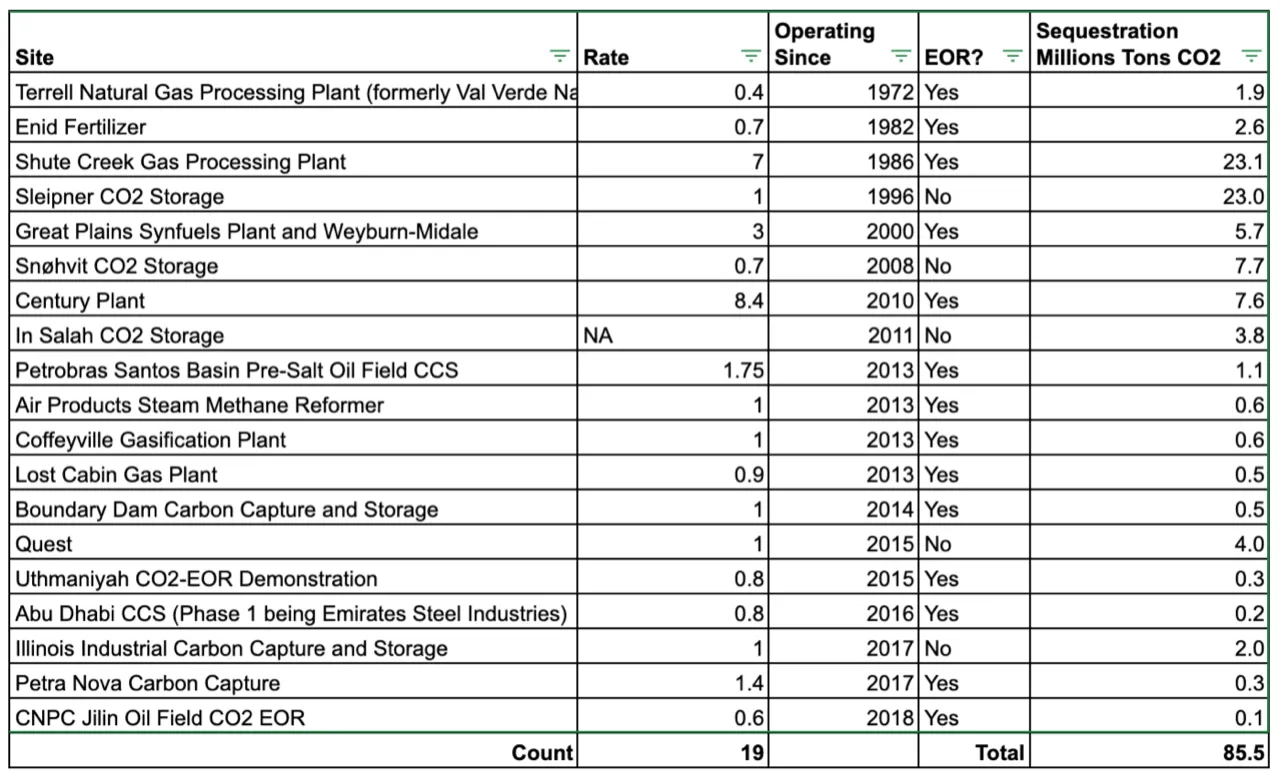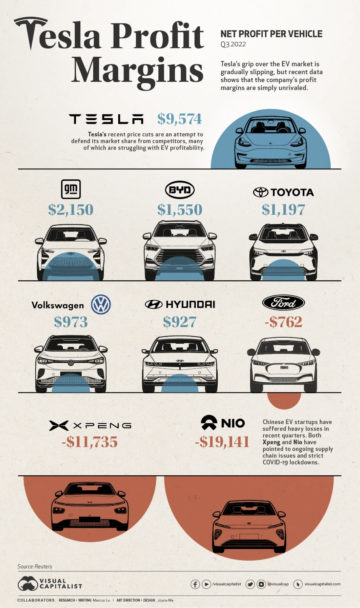Sign up for daily news updates from CleanTechnica on email. Or follow us on Google News!
Carbon capture and sequestration in all of its various ineffective, inefficient, and expensive forms is having another run up the hype cycle. Nothing has really changed. The problems still exist. The alternatives are still better. The potential for use is still minuscule. And so, we’ve got this CCS Redux series, republishing old CCS articles with minor edits.
ExxonMobil spins great PR hay out of its carbon straw. The company claims to be the global leader in getting rid of CO2. Like almost everything else in the carbon capture and sequestration space (CCS), the claims do not hold up to the slightest scrutiny.
Its claim came to my attention recently [in 2019], after the numerous assessments of the CCS space I’ve published over the past year or so. I was wondering where the specific number came from. I dug around quickly and found this on its CCS page:
With a working interest in approximately one-fifth of the world’s total carbon capture capacity, ExxonMobil is a leader in one of the most important next-generation low-greenhouse gas emissions technologies, capturing about 7 million tonnes per year of CO2. Since 1970, ExxonMobil has cumulatively captured more CO2 than any other company — accounting for more than 40 percent of cumulative CO2 captured.
Let’s tear this apart and see if it holds up.
First off, though, let’s look at 7 million tons per year of CO2. That sounds awesome, until you realize that the global problem is in the range of 3,200 billion excess tons of CO2 in the atmosphere. Yeah, regardless of how relatively well ExxonMobil does or doesn’t do compared to other CCS schemes, this is 6 orders of magnitude away from the scale of the problem.
Fail #1: 6 orders of magnitude too small
Next, let’s look at the biggest 19 CCS endeavors in the world per the Global CCS Institute, a petroleum industry PR think tank that spins this space for the oil, gas, and coal majors. I annotated its numbers for an earlier article to provide useful context.

There are a couple of interesting things here related to ExxonMobil’s claim. The first is that only 19 million tons of CO2 are being captured annually by the biggest CCS schemes in the world, so ExxonMobil is claiming 37% of that. Secondly, there are only 4 of 19 sites that aren’t actually enhanced oil recovery (EOR) sites.
What is that and why is it important? EOR with CO2 pumps CO2 underground in played out oil wells. That liquifies more of the sludge allowing more oil to be extracted. For every ton of CO2 pumped underground, a quarter ton comes back up. When that’s burned as the vast majority of oil is, it turns into about 0.8 tons of CO2, disregarding the upstream carbon-debt of capturing and transporting the CO2. That means that the 14 million tons used annually for EOR under claimed CCS programs are only sequestering about 2.8 million tons in the best case scenario.
As I pointed out in an assessment of ‘best’ CCS example in the world, the Norwegian non-EOR Sleipner CCS facility, the natural gas the CO2 is extracted from turns into 25 times the CO2 sequestered.
So is there merit to ExxonMobil’s claim? Is it behind 7 million of the 19 million at all, regardless of EOR?
Well, the company can make that claim, yes. It owns the Shute Creek facility in Labarge, Wyoming, which does have a claimed 7 million ton per year capacity and has been in operation since 1986.
Where is the CO2 coming from? Well, they pump it up in one place from underground where it’s already sequestered, pipe it a few tens of miles and then pump it back underground. It’s mixed with natural gas in too large an amount, just like the Sleipner facility, so they have to separate them.
Fail #2: it’s a shell game, not capturing CO2 at all.
And it is an EOR facility. That’s only 1.4 million tons at most of CO2 actually going away annually. Worse, when they don’t need the CO2 for EOR, the just dump it into the air.
Fail #3: pumping oil with the CO2
Hmmm, how does that compare to its CO2 emissions? Well, per Statista, it is running 6.1 million barrels of oil daily. That’s about 2,200 million barrels annually. Each barrel of oil turns into about 0.433 tons of CO2. That’s right, a single barrel turns into over 40% of a ton of CO2.
That means that ExxonMobil pumps sufficient oil annually to create just under a billion tons of CO2 annually by itself. And it is actually sequestering about a thousandth of that amount of CO2 after you look at EOR.
Fail #4: 1,000 times less captured than emitted
So what does this all net out to? Yes, there’s the a grain of truth in what ExxonMobil says. It is pretty much the biggest carbon sequestration organization in the world, the way that those organizations count things, which is pretty lame. But it’s not capturing carbon, far from it.
The company excludes any reference to the scale of the problem that it specifically is creating. And it excludes any reference to the larger scale of the problem, of which it is a small part. And it doesn’t provide context for the CO2 scale compared to the scale of the emissions that it is responsible for.
It claims value from taking CO2 out of the ground in one place and shoving it back underground in another place to get more oil.
ExxonMobil’s CCS claims are PR nonsense, designed in multiple ways to confuse and dissemble, allowing it the social license to keep on pumping oil and causing global warming. Unsurprisingly.
Have a tip for CleanTechnica? Want to advertise? Want to suggest a guest for our CleanTech Talk podcast? Contact us here.
Latest CleanTechnica TV Video
[embedded content]
I don’t like paywalls. You don’t like paywalls. Who likes paywalls? Here at CleanTechnica, we implemented a limited paywall for a while, but it always felt wrong — and it was always tough to decide what we should put behind there. In theory, your most exclusive and best content goes behind a paywall. But then fewer people read it!! So, we’ve decided to completely nix paywalls here at CleanTechnica. But…
Thank you!
Advertisement
CleanTechnica uses affiliate links. See our policy here.
- SEO Powered Content & PR Distribution. Get Amplified Today.
- PlatoData.Network Vertical Generative Ai. Empower Yourself. Access Here.
- PlatoAiStream. Web3 Intelligence. Knowledge Amplified. Access Here.
- PlatoESG. Carbon, CleanTech, Energy, Environment, Solar, Waste Management. Access Here.
- PlatoHealth. Biotech and Clinical Trials Intelligence. Access Here.
- Source: https://cleantechnica.com/2024/02/24/ccs-redux-exxonmobils-co2-sequestration-is-just-a-tiny-fraction-of-its-co2-emissions/
- :has
- :is
- :not
- :where
- $UP
- 000
- 1
- 14
- 15%
- 19
- 2%
- 200
- 200 billion
- 2019
- 25
- 36
- 4
- 40
- 6
- 7
- 8
- a
- About
- actually
- Advertise
- Affiliate
- After
- AIR
- All
- Allowing
- almost
- already
- alternatives
- always
- amount
- an
- and
- Annually
- Another
- any
- apart
- approximately
- ARE
- around
- articles
- AS
- assessment
- assessments
- At
- Atmosphere
- attention
- away
- awesome
- back
- barrels
- BE
- been
- behind
- being
- BEST
- Better
- Biggest
- Billion
- Bit
- burned
- but
- by
- came
- CAN
- Capacity
- capture
- captured
- Capturing
- carbon
- carbon capture
- Carbon Sequestration
- case
- causing
- changed
- chief
- chip
- claim
- claimed
- claiming
- claims
- cleantech
- Cleantech Talk
- co2
- co2 emissions
- Coal
- comes
- coming
- Companies
- company
- compare
- compared
- completely
- content
- context
- count
- Couple
- create
- Creating
- Creek
- cycle
- daily
- decide
- decided
- designed
- disregarding
- do
- does
- Doesn’t
- don
- Dont
- dump
- each
- else
- embedded
- Emissions
- endeavors
- enhanced
- Every
- everything
- example
- excess
- Exclusive
- exist
- expensive
- exxonmobil
- facilities
- Facility
- far
- felt
- few
- fewer
- First
- For
- forms
- found
- fraction
- from
- game
- GAS
- get
- getting
- Global
- global warming
- Globally
- Goes
- going
- got
- great
- Ground
- Guest
- Have
- having
- help
- here
- hold
- holds
- How
- HTTPS
- Hype
- i
- if
- implemented
- important
- in
- industry
- inefficient
- Institute
- interest
- interesting
- into
- IT
- ITS
- itself
- just
- Keep
- large
- larger
- leader
- less
- License
- like
- likes
- Limited
- links
- Look
- magnitude
- Majority
- Majors
- make
- max-width
- means
- Media
- Merit
- Michael
- million
- millions
- minor
- mixed
- more
- most
- much
- multiple
- my
- Natural
- Natural Gas
- Need
- net
- New
- news
- next-generation
- nothing
- number
- numbers
- numerous
- of
- off
- Oil
- Old
- on
- ONE
- only
- operation
- or
- orders
- organization
- organizations
- Other
- our
- out
- over
- owns
- part
- past
- People
- per
- percent
- Petroleum
- pipe
- Place
- plato
- Plato Data Intelligence
- PlatoData
- played
- player
- podcast
- policy
- potential
- pr
- pretty
- Problem
- problems
- Programs
- provide
- publish
- published
- pump
- pumping
- pumps
- put
- Quarter
- quickly
- range
- Read
- Reader
- realize
- really
- recently
- recovery
- Redux
- reference
- Regardless
- related
- relatively
- responsible
- Rid
- right
- Run
- running
- says
- Scale
- scenario
- schemes
- scrutiny
- see
- separate
- sequestration
- Series
- Shell
- should
- since
- single
- Sites
- small
- So
- Social
- sounds
- Space
- specific
- specifically
- spins
- Still
- Stories
- Strategist
- Strategy
- sufficient
- suggest
- support
- T
- table
- taking
- Talk
- tank
- team
- Technologies
- tens
- than
- that
- The
- the world
- Them
- then
- theory
- There.
- they
- things
- Think
- think tank
- this
- those
- though?
- times
- tiny
- tip
- to
- Ton
- tons
- too
- Total
- tough
- transporting
- truth
- turns
- tv
- under
- underground
- until
- Updates
- us
- use
- used
- useful
- uses
- value
- various
- Vast
- Ve
- Video
- want
- was
- Way..
- ways
- we
- webp
- WELL
- Wells
- What
- when
- which
- while
- WHO
- why
- with
- wondering
- working
- world
- world’s
- worse
- write
- Wrong
- Wyoming
- year
- yes
- you
- Your
- youtube
- zephyrnet








